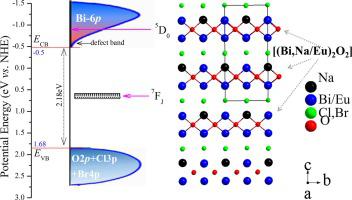Applied Surface Science ( IF 6.3 ) Pub Date : 2021-08-03 , DOI: 10.1016/j.apsusc.2021.150814 Donglei Wei 1 , Xifeng Yang 1 , Yushen Liu 1 , Hyo Jin Seo 2

|
Two-dimensional bismuth layered oxyhalogenides have excellent photoelectric applications for energy conversion and storage due to its unique crystal structures, narrow band gaps. In this work, we reported an indirect semiconductor NaBi3O4Cl1.5Br0.5 prepared via sol–gel synthesis with the subsequent solid-state reaction. This is a typical bismuth layered framework characterized by [Bi2O2]2+ slab intercalated with [Cl/Br]− layers. There are distinct influences of rare ions (La3+, Gd3+, Eu3+) doping on the optical properties of NaBi3O4Cl1.5Br0.5. La3+ and Gd3+ doping slightly narrowed the band gap (several nanometers) of NaBi3O4Cl1.5Br0.5, while the band energy was greatly decreased from 2.37 eV to 2.18 eV via the Eu3+ doping in the lattice. As far as photochemical properties are concerned, La3+/Gd3+ doping didn’t show an obvious contribution, while, Eu3+-doping gave an improvement to photodegradation. A comparison with DFT calculations revealed that Eu-4f could bring about the isolated energy band intersecting the forbidden band of NaBi3O4Cl1.5Br0.5, which was suggested to enhance photodegradation and delay the recombination of light-generated electrons and holes. Eu3+-doped NaBi3O4Cl1.5Br0.5 is favorable for photocatalysis, but is not favorable for photoluminescence application. This bismuth layered semiconductor can be expected to have possible applications in developing advanced energy conversion or energy storage materials such as photocatalyst, optoelectronics, and batteries.
中文翻译:

在铋层状卤氧化物半导体 NaBi3O4Cl1.5Br0.5 中基于 Eu3+ 掺杂促进染料溶液的光降解
由于其独特的晶体结构和窄带隙,二维铋层状卤氧化物在能量转换和存储方面具有出色的光电应用。在这项工作中,我们报道了通过溶胶-凝胶合成和随后的固态反应制备的间接半导体 NaBi 3 O 4 Cl 1.5 Br 0.5。这是典型的铋层状骨架,其特征在于 [Bi 2 O 2 ] 2+板条插入 [Cl/Br] -层。稀有离子(La 3+ , Gd 3+ , Eu 3+ )掺杂对NaBi 3的光学性质有明显影响O 4 Cl 1.5 Br 0.5。La 3+和Gd 3+ 的掺杂略微缩小了NaBi 3 O 4 Cl 1.5 Br 0.5的带隙(几个纳米),而通过晶格中的Eu 3+掺杂,带能从2.37 eV大幅降低到2.18 eV 。就光化学性质而言,La 3+ /Gd 3+掺杂没有表现出明显的贡献,而Eu 3+-掺杂改善了光降解。与 DFT 计算的比较表明,Eu-4f 可以带来与 NaBi 3 O 4 Cl 1.5 Br 0.5禁带相交的孤立能带,这被认为可以增强光降解并延迟光生电子和空穴的复合。Eu 3+掺杂 NaBi 3 O 4 Cl 1.5 Br 0.5有利于光催化,但不利于光致发光应用。这种铋层状半导体有望用于开发先进的能量转换或储能材料,如光催化剂、光电子和电池。











































 京公网安备 11010802027423号
京公网安备 11010802027423号